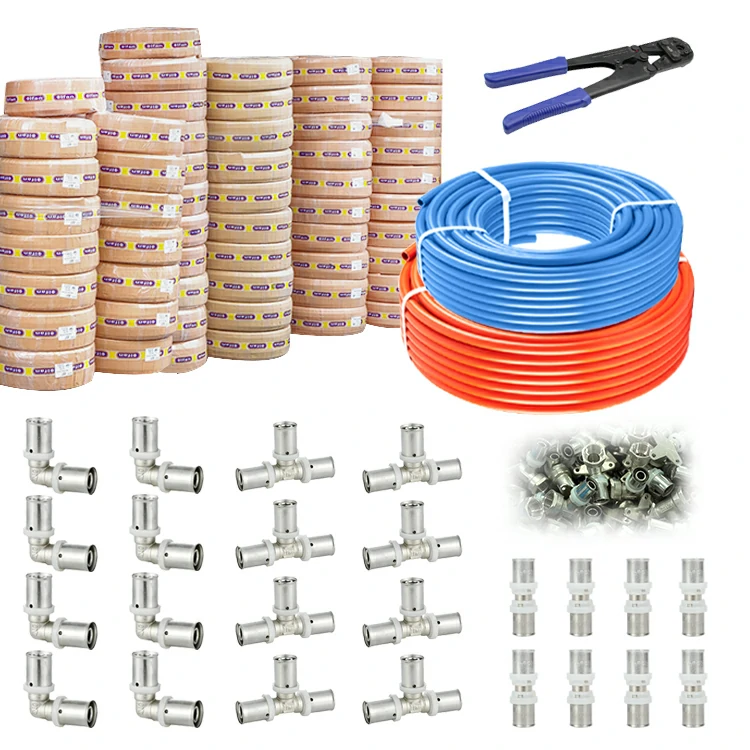The difference between brass press fittings and copper press fittings primarily lies in the material composition, durability, cost, and applications. Here’s a breakdown of the key differences:
1. Material Composition
- Brass Press Fittings: Made from an alloy of copper, zinc, and sometimes other metals like lead or tin. Brass is known for its durability, corrosion resistance, and strength.
- Copper Press Fittings: Made primarily from copper, which is a naturally corrosion-resistant material. Copper fittings are often used in systems where high reliability and long-term performance are critical.
2. Corrosion Resistance
- Brass Press Fittings: Brass has good corrosion resistance, but it can still be susceptible to dezincification (corrosion caused by the zinc component leaching out in certain conditions). This can make brass fittings less durable in environments with highly acidic or alkaline water.
- Copper Press Fittings: Copper is highly resistant to corrosion, especially in potable water systems. It’s particularly effective in preventing the build-up of mineral deposits and scale, which can occur in water systems.
3. Strength and Durability
- Brass Press Fittings: Brass is generally stronger and more robust than copper. It is highly resistant to mechanical wear and can withstand higher pressures, making it suitable for a wider range of applications, including gas and high-pressure systems.
- Copper Press Fittings: While copper fittings are durable and strong, they are generally not as robust as brass fittings when it comes to mechanical impact. Copper can be more easily damaged if subjected to heavy impact.
4. Cost
- Brass Press Fittings: Typically, brass fittings are more expensive than copper fittings due to the materials used and the manufacturing process. However, the increased durability and strength can make brass fittings a more cost-effective choice in certain applications.
- Copper Press Fittings: Copper fittings are usually less expensive than brass fittings but may not offer the same level of strength or resistance to wear, depending on the application.
5. Applications
- Brass Press Fittings: These fittings are widely used in gas installations, commercial plumbing, and heating systems. Their durability and ability to handle high pressures make them ideal for industrial and commercial applications.
- Copper Press Fittings: Copper fittings are commonly used in drinking water systems, HVAC systems, and low-pressure water systems. Copper’s natural resistance to corrosion and its antimicrobial properties make it a popular choice for potable water systems.
6. Installation
- Brass Press Fittings: Brass press fittings are installed using a special tool that crimps the fitting onto the pipe, creating a tight, leak-free seal. The installation process is generally quick and easy, which reduces labor costs.
- Copper Press Fittings: Like brass fittings, copper press fittings are also installed using a press tool. The installation method is similar, but copper fittings can sometimes require more careful handling due to the softer nature of the material.
7. Appearance
- Brass Press Fittings: Brass has a distinctive yellow-golden color and may develop a patina over time, especially in outdoor environments.
- Copper Press Fittings: Copper fittings have a reddish-brown appearance, which can turn green (a patina) over time due to oxidation.
8. Environmental Impact
- Brass Press Fittings: Brass fittings may contain small amounts of lead, especially older models. Modern brass fittings, however, are often made with lead-free alloys to meet health and safety regulations for drinking water systems.
- Copper Press Fittings: Copper is a recyclable material and is often preferred in environmentally-conscious plumbing systems. It is also naturally antimicrobial, which can be beneficial for potable water systems.
Conclusion:
- Brass press fittings are ideal for high-pressure applications, gas systems, and areas where higher durability and strength are required. They are more expensive but provide excellent long-term performance, especially in demanding environments.
- Copper press fittings are typically used for drinking water systems, HVAC, and residential plumbing, offering good corrosion resistance and a more affordable option for less demanding applications.
The choice between brass and copper press fittings depends largely on the specific requirements of your plumbing system, including pressure ratings, durability, and budget considerations.
Standard:ASTM F1974,ASTM F1281,CSA B137,DIN 16836,GB18997,ISO 21003.It is their standard,so it product is safety and Professional.
View more:https://www.ifanfittings.com/


